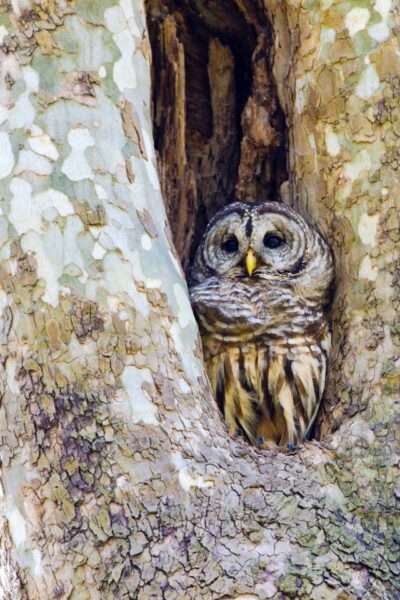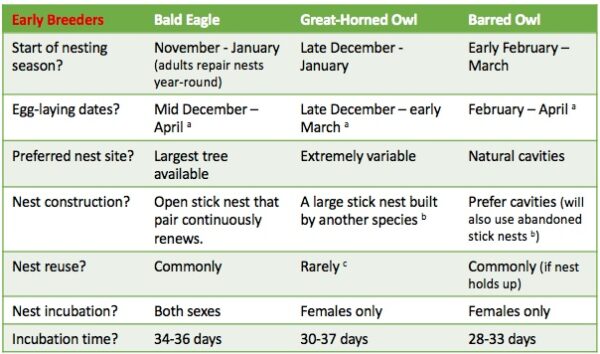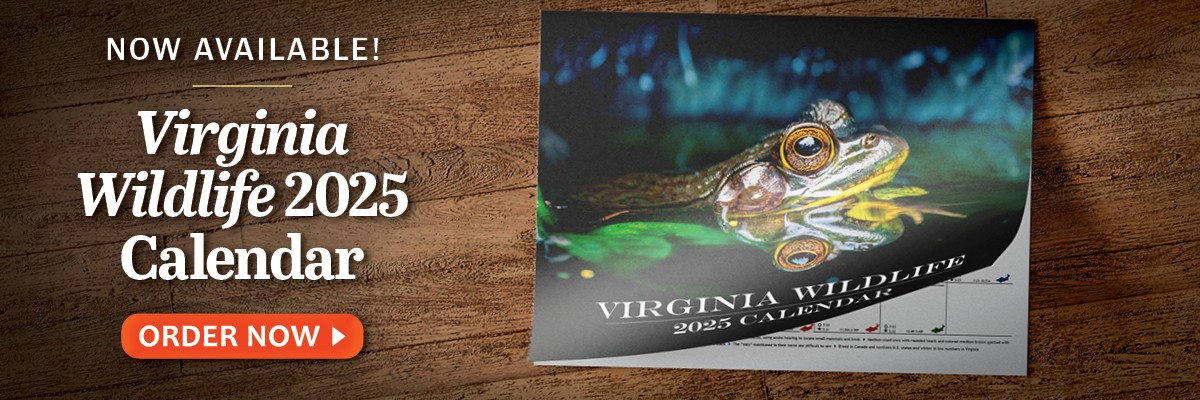By Ashley Peele

Barred Owl at James River Wetlands Park by Bob Schamerhorn
The season for Christmas Bird Counts has arrived!
As we head into the end of 2016, birders’ thoughts may turn more and more toward the start of the 2017 breeding season. These are not premature, because several of Virginia’s resident raptor species, or birds of prey, begin breeding far earlier than springtime. In this article, we’ll focus on the Bald Eagle, Great Horned Owl, and Barred Owl, all of which begin their breeding activities in early- to late-winter. Size, behavior, and adaptations allow these birds to begin breeding much earlier than smaller or less cold-tolerant species. For example, the eggs of a Great Horned Owl can withstand temperatures as low as -13 Fahrenheit, if the mother is forced to leave the nest for a short time. To dive in more deeply, check out how these three species compare in timing and characteristics of breeding behavior…
 (a) This window of time can vary significantly, depending on seasonal climate conditions and food availability. Dates should be taken as ballpark estimates only. (b) Most owl species rely on cavities or nests built by others. Both Great-Horned and Barred Owls do no maintenance and do not add to existing nests. (c) Given the lack of maintenance by owl species, nests usually fall apart after one season. However, a Great-Horned Owl pair may use the crotch of a large tree for a nest site. Such ‘nests’ can last for many seasons, so the pair will reuse them year after year (10+ years at same site by same pair has been documented).
(a) This window of time can vary significantly, depending on seasonal climate conditions and food availability. Dates should be taken as ballpark estimates only. (b) Most owl species rely on cavities or nests built by others. Both Great-Horned and Barred Owls do no maintenance and do not add to existing nests. (c) Given the lack of maintenance by owl species, nests usually fall apart after one season. However, a Great-Horned Owl pair may use the crotch of a large tree for a nest site. Such ‘nests’ can last for many seasons, so the pair will reuse them year after year (10+ years at same site by same pair has been documented).
Christmas bird counts (CBC) are certainly a great time to start keeping your eyes peeled for these early breeding species. If you’re doing any owl surveys as part of your CBC, use this as an opportunity to scout the area for the Atlas project. Any of the three species described above are likely hanging out in their future nesting territory already. CBCs give you the chance to find those territories and maybe even get a jump on preliminary breeding data for the 2017 Atlas season.

Bald Eagle Pair by Bob Schamerhorn
Quick Atlaser Story! This morning an Atlas volunteer contacted me about a pair of Bald Eagles that are already beginning to hang out at a nest site in SW Virginia. It may be one, two, or even three months before the female begins laying eggs, but now this volunteer knows to keep eyes on this nest. So, it begins!
Some Other Quick Tips for Using the Winter to Prep for the 2017 Atlas Season
Many Atlas volunteers write to share their efforts and field activities with me. I appreciate receiving these stories and feedback, because it helps me to know what recommendations are proving effective and what still needs tweaking. Here are some of the ways that Atlas volunteers are using their ‘down time’ this winter to prep for the upcoming 2017 breeding season:
- Practicing how to enter their observations in eBird. I may sound like a broken record, but winter is truly the best time to practice your birding skills and your eBird skills. There are fewer species around and they are easier to see (no leaves!). Makes things much simpler!
- Scouting their Atlas block(s) for next spring. Several Atlasers have told me they are using the winter to do a little driving around their Atlas blocks. This helps them figure out what habitats are there, what property access will be like, and where they will prioritize for their Atlas survey effort.
- Learning the breeding codes (and reviewing the Atlas handbook). Many folks feel overwhelmed by the amount of information they think needs to already exist in their head. In reality, we’ve provided you with a lot of reference tools. These tools exist so that you don’t have to know everything. Instead, use the winter to familiarize yourself with all our resources, so you know where to look when questions arise in the spring and summer.
- Birding with other Atlas volunteers. Many folks have told me that they got over the ‘Atlas anxiety’ after ONE outing with a fellow birder. It’s so easy to psych ourselves into thinking that this project is super complicated and we’re not qualified to contribute to this project. Going out with other volunteers can dispel these fears and show you what a great contribution you can make. Confession! I still often look up breeding biology questions too! No one expects you to know it all. What matters most is that you know where to look to find the right answers.
I’ll conclude for now, but as always, remember to send any questions you have to your regional or state Atlas Coordinator. We appreciate all that you have done and continue to do for the success of this project.
Keep your eyes peeled for many more Atlas updates and new events starting early next year. We’re going to hit the ground running in 2017 with as many eyes and ears in the field as we can muster!
Best wishes for wonderful holidays full of family, friends, and of course, excellent birds.
www.vabba2.org | ebird.org/atlasva | www.facebook.com/vabba2


